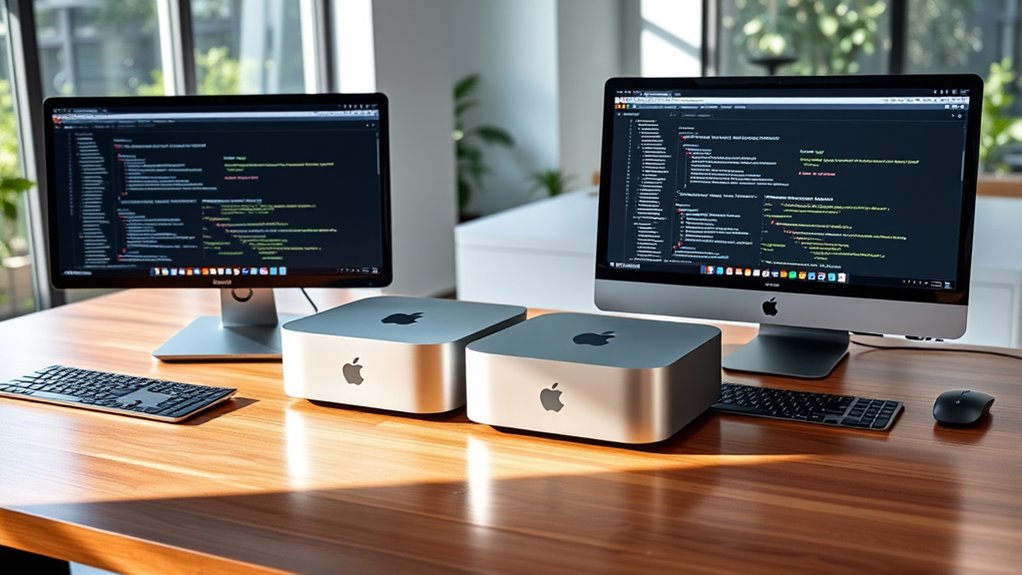If you’re looking for the best Mac minis for software development in 2025, I recommend focusing on models with the latest M4 chips, including the M4 and M4 Pro, as they deliver powerful performance and great multitasking capabilities. The 2024 Mac mini with M4 offers improved specs, and the M4 Pro version ensures smoother handling of demanding tasks. Keep an eye on storage and connectivity options to future-proof your setup. Stay tuned if you want the full details on these top picks.
Key Takeaways
- The latest 2024 Mac Mini with M4 chip offers high performance and ample RAM for demanding development tasks.
- M4 Pro models provide additional CPU and GPU power, ideal for intensive software development and multitasking.
- External storage options are recommended due to limited internal SSD capacity, ensuring scalability for large projects.
- Multiple connectivity ports like Thunderbolt and HDMI facilitate seamless peripheral and monitor integration.
- Future-proof options with higher RAM and processing power ensure reliable performance into 2025 and beyond.
Apple Mac mini Desktop Computer with M4 Chip (256GB SSD, 16GB RAM)
If you’re looking for a compact yet powerful machine for software development, the Apple Mac mini with M4 chip is an excellent choice. Its small, five-by-five-inch design fits easily on any desk or next to your monitor, yet it packs impressive performance. The M4 chip features a 10-core CPU and GPU, delivering smooth, rapid processing. With 16GB of unified memory and a 256GB SSD, you get fast multitasking and ample space for projects. Plus, its versatile ports—Thunderbolt, HDMI, USB-C, Ethernet—make connectivity simple. Built for macOS, it integrates seamlessly with Apple’s ecosystem, boosting productivity while maintaining top-tier performance in a tiny package.
Best For: software developers and creative professionals seeking a compact, high-performance desktop that seamlessly integrates with the Apple ecosystem.
Pros:
- Compact design fits easily in small spaces and next to monitors
- Powerful M4 chip with 10-core CPU and GPU ensures smooth multitasking and processing
- Versatile connectivity options including Thunderbolt, HDMI, USB-C, Ethernet, and headphone jack
Cons:
- Limited internal storage at 256GB may require external drives for large projects
- No dedicated graphics card, which may affect high-end gaming or intensive 3D rendering
- Higher price point compared to some other small form factor PCs with similar specs
Apple Mac mini Desktop Computer with M4 Chip (2024)
The Apple Mac mini Desktop Computer with M4 Chip (2024) stands out as an excellent choice for software developers who need powerful performance in a compact form factor. Its sleek 5×5-inch design easily fits on any desk, next to a monitor or in tight spaces. Powered by the M4 chip with a 10-core CPU and GPU, plus 16GB of unified memory and 512GB SSD, it handles demanding tasks smoothly. With multiple ports—including Thunderbolt, HDMI, and front USB-C—it offers versatile connectivity. Seamlessly integrated into the Apple ecosystem, it enhances productivity and privacy, all while being environmentally friendly. It’s a compact powerhouse built for modern development needs.
Best For: Software developers and creative professionals seeking a compact, powerful, and eco-friendly desktop with seamless Apple ecosystem integration.
Pros:
- Compact 5×5-inch design easily fits in small or cluttered workspaces
- Robust performance with M4 chip, 16GB memory, and 512GB SSD for demanding tasks
- Versatile connectivity options including Thunderbolt, HDMI, and front USB-C ports
Cons:
- Limited upgradability due to integrated hardware design
- Higher price point compared to similarly specced traditional PCs
- May require adaptation for users accustomed to Windows or other ecosystems
Apple 2024 Mac mini Desktop Computer with M4 Chip
Designed around the powerful M4 chip, the Apple 2024 Mac mini Desktop Computer offers an ideal combination of compact size and high performance, making it perfect for software developers who need a space-saving yet capable machine. Its five-by-five-inch design fits seamlessly beside monitors and in tight spaces while delivering impressive speed with a 10-core CPU and GPU. With 24GB of unified memory and a 512GB SSD, multitasking and data access are lightning-fast. Built for Apple Silicon, it supports apps like Microsoft 365 and Adobe Creative Cloud, ensuring smooth workflow. Plus, it’s environmentally friendly and packed with privacy features, making it a reliable choice for any development setup.
Best For: software developers and tech enthusiasts seeking a compact, high-performance desktop with seamless Apple ecosystem integration.
Pros:
- Compact design fits easily in tight spaces and beside monitors
- Powered by the efficient M4 chip with a 10-core CPU and GPU for fast performance
- Supports professional applications like Microsoft 365 and Adobe Creative Cloud with optimized compatibility
Cons:
- Limited to 512GB SSD storage, which may require external solutions for large data needs
- Only includes front-facing USB-C ports, potentially requiring adapters for additional peripherals
- As a desktop, it may lack the expandability of traditional tower computers
Apple Mac mini Desktop Computer with M4 Pro Chip
For software developers seeking powerful performance in a compact form, the Apple Mac mini with the M4 Pro chip stands out as an ideal choice. Its five-by-five-inch design fits perfectly next to monitors or in tight spaces, yet it packs serious hardware. The M4 Pro’s 12-core CPU and 16-core GPU deliver blazing speeds for demanding tasks like large code compilations and complex scenes. With 24GB of unified memory and a 512GB SSD, it handles multitasking effortlessly. Plus, its rich array of ports—including Thunderbolt, HDMI, and USB-C—ensures seamless connectivity. Optimized for Apple Silicon and macOS, this mini powerhouse integrates effortlessly into the Apple ecosystem.
Best For: software developers and power users seeking a compact yet high-performance desktop that seamlessly integrates within the Apple ecosystem.
Pros:
- Compact design fits easily in tight spaces while delivering desktop-level performance
- Powerful M4 Pro chip with 12-core CPU and 16-core GPU handles demanding tasks efficiently
- Seamless connectivity through a wide range of ports including Thunderbolt, HDMI, and USB-C
Cons:
- Limited upgrade options due to compact size and integrated hardware
- Higher price point compared to traditional mini PCs with similar specs
- May require external peripherals for complete workstation setup
Factors to Consider When Choosing the Mac Mini for Software Development

When choosing a Mac Mini for software development, I consider several key factors. It’s important to match processing power, memory, and storage to your project needs, ensuring smooth performance. Additionally, checking connectivity options and software compatibility helps avoid future limitations.
Processing Power Needs
Choosing the right Mac mini for software development largely depends on its processing power, as many tasks demand a high-performance CPU. I recommend opting for models with the M4 or M4 Pro chip, which deliver the speed needed for complex compile processes and multitasking. A 10-core or higher CPU considerably enhances build times and responsiveness during intensive coding sessions. For resource-heavy tasks like running virtual machines or emulators, at least 16GB of unified memory is vital to keep everything running smoothly. Faster processing reduces latency when running tests and debugging, boosting productivity. Investing in higher processing capabilities ensures your Mac mini can handle future software updates and larger projects, making it a reliable tool for ongoing development needs.
Memory Capacity Requirements
Since multitasking and running multiple development tools are common in software projects, having sufficient RAM is essential for smooth performance. At a minimum, 8GB of RAM supports basic development tasks, but larger projects benefit from 16GB or more to improve performance and reduce compile times. Adequate memory helps prevent slowdowns when running virtual machines, emulators, or containerized environments, which are often necessary for testing and deployment. It also guarantees your system can handle large codebases, datasets, and resource-heavy applications without frequent swapping or lag. For future-proofing, opting for 24GB or 32GB of RAM can extend your Mac Mini’s usefulness as your projects grow more complex and demanding. Balancing your budget with these needs will help you select the right configuration.
Storage Space Adequacy
Adequate storage space is essential for smooth software development on a Mac Mini, as it allows you to keep large project files, libraries, and virtual machines readily accessible. I recommend a minimum of 512GB SSD to comfortably handle multiple applications, tools, and sizable datasets without constant external drive reliance. If your work involves resource-intensive applications, large databases, or multi-platform environments, consider upgrading to 1TB or more. Larger storage not only accommodates current projects but also provides extra room for future growth and backups, reducing the hassle of data management. Fast SSD storage improves load times and overall system responsiveness, which are critical for maintaining efficient workflows. Prioritizing sufficient storage guarantees your development environment remains seamless and scalable as your projects evolve.
Connectivity Options
When selecting a Mac Mini for software development, it’s essential to pay close attention to its connectivity options. You’ll want enough ports like Thunderbolt and USB-C to connect multiple peripherals, such as external drives, monitors, and development devices. Versatile options like HDMI and Ethernet ports are fundamental for stable internet and external display support. Front-facing ports for quick access to USB-C and headphones help streamline your workflow. Consider models with higher bandwidth ports to guarantee fast data transfers, especially when working with large codebases or running virtual machines. Additionally, check compatibility with your existing accessories and peripherals to avoid connectivity issues. Reliable, flexible connectivity options are indispensable for maintaining an efficient, distraction-free development environment.
Software Compatibility
Choosing a Mac Mini for software development means guaranteeing it can run all the necessary operating systems and development tools smoothly. I check that the device supports my preferred OS versions and the tools I rely on, like Xcode, Visual Studio Code, or JetBrains IDEs. Compatibility with programming languages and frameworks is vital, so I verify that hardware specs meet the demands of my projects, including CPU, RAM, and storage. I also guarantee the Mac Mini’s ports and connectivity options support peripherals such as external monitors, keyboards, and testing devices. If my environment requires running multiple OS or isolated setups, I consider virtualization or containerization software availability. This helps me select a device that seamlessly integrates with my workflow without compatibility hiccups.
Budget Considerations
Budget considerations play a pivotal role in selecting the right Mac Mini for software development, as they directly influence which models and configurations are accessible. I recommend first setting a clear budget range to determine which Mac Mini options fit within your financial limits. It’s important to weigh the cost differences between models with varying RAM, storage, and processors to balance performance and expenses effectively. Higher-spec models, like those with M4 Pro chips, tend to be pricier but offer better future-proofing, which can save you money long-term. Don’t forget to factor in additional costs for accessories such as external monitors, keyboards, and storage devices. Investing in a more powerful Mac Mini now might align with your long-term development goals, reducing the need for future upgrades.
Frequently Asked Questions
How Does the M4 Pro Chip Compare to the Standard M4 in Performance?
The M4 Pro chip outperforms the standard M4 considerably, especially in processing power and multitasking. I’ve noticed that it handles demanding development tasks, like compiling code or running multiple virtual machines, much more smoothly. The Pro version offers better GPU capabilities and higher RAM options, making it ideal for intensive software development. If you’re serious about performance, I’d definitely recommend the M4 Pro over the standard M4.
Are There Specific Mac Mini Models Better Suited for Ios Development?
Think of choosing a Mac Mini for iOS development like picking a reliable steed. The M1 and M2 Mac Minis, especially those with more RAM and storage options, are your best bets. They’re fast, efficient, and optimized for Xcode and iOS simulators. I’d steer clear of older models—they just don’t have the horsepower for seamless app testing. For a smooth ride, go for the latest M2 models with ample memory.
What Is the Recommended RAM for Intensive Software Development Tasks?
I recommend at least 16GB of RAM for intensive software development tasks. If you’re working on large projects, running multiple virtual machines, or using heavy IDEs, 32GB or more can considerably boost performance and prevent slowdowns. More RAM allows your Mac Mini to handle demanding workloads smoothly, making development more efficient. So, investing in higher RAM ensures you won’t be bottlenecked by memory constraints during your most intense coding sessions.
How Upgradeable Are the Storage Options on These Mac Minis?
Think of storage like a garden—you want room to grow. On the Mac Minis, the storage options are not user-upgradable; they’re sealed tight, like a vault. So, it’s essential to choose wisely when you buy, considering your future needs. If you anticipate large projects, opt for the highest storage option available. Once set, you’ll need to rely on external drives for expansion, so plan ahead.
Do Newer Mac Minis Support External GPU Connections for Extra Power?
Yes, newer Mac Minis do support external GPU connections, but with some limitations. I’ve found that connecting an eGPU via Thunderbolt 3 or 4 can boost graphics performance, especially for demanding development tasks. However, not all models or configurations support this feature perfectly. If you’re planning to use an external GPU, make sure to check compatibility for your specific Mac Mini model to get the best results.
Conclusion
Choosing the right Mac mini is like picking the perfect tool for a craftsman’s hand—when it fits, everything flows smoothly. Whether you’re after raw power or efficiency, these four options in 2025 stand out as reliable partners in your coding journey. Remember, the best Mac mini for you is the one that feels like an extension of your creativity, ready to turn your ideas into reality with unwavering power and performance.











